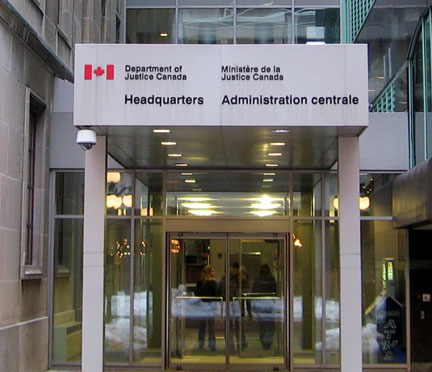It was a problem Justice Department lawyer Pamela McCurry could see looming. In the wake of the 2008 financial downturn, the federal government put together a massive rescue package, pumping billions of dollars into infrastructure programs to prop up Canada’s economy.

McCurry, an assistant deputy attorney general in the aboriginal affairs section and a veteran of previous cost-cutting exercises, knew the money was going to have to come from somewhere. Sooner or later, the government was going to be looking for ways to rebalance its budget and cut its costs, including legal expenses.
“We were going to have less money to respond to the legal needs of government in the area of aboriginal issues,” says McCurry
That foresight and her success in cutting costs while maintaining top-quality legal services recently earned McCurry the Public Service Award of Excellence, one of the highest honours handed out to federal public servants.
A group of Justice Department lawyers and officials from Public Safety Canada who administered the ex gratia payment program following the Air India disaster were also among those honored in the 2014 awards.
While the awards were for their performance within the public service, the lawyers say there are lessons for others in the legal profession.
For McCurry, the biggest lesson was about how to respond to a client’s desire to reduce legal costs while maintaining the same level of service, a problem many law firms across Canada are facing.
“It’s really a question of how can you respond to demand that may not have declined, may be stable, may be shifting when there is downward pressure on your revenues because clients don’t want to pay or they can’t pay,” says McCurry. “It’s all about finding ways to reduce your overall cost structure so you can deliver excellence and meet their needs along the way.”
The secret to her success, she says, is data.
“When you are trying to figure out how you can reduce your cost structure, you need to have data. You need to know where to look. Otherwise, if you do it on a random basis, you’re likely to make some important and costly mistakes. Your data can point the way.
“Your data can also set the table for really good discussions with your clients because it becomes shared knowledge. It is what it is. The numbers don’t lie. They also point the way for a really good discussion around managing both demand and supply because clients have a real role in it. It’s how they use their lawyers and how they are using their lawyers actually does show up in the numbers.”
Data also helps to rally staff, she notes.
Federal Justice Department data, combined with a litigation efficiency review, allowed McCurry to pinpoint a couple of areas where it was spending the most money. Those, of course, were areas where it could drill down to find savings. While the cost-cutting exercise at the Justice Department has been successful, it hasn’t been without controversy. The government has cut dozens of lawyer positions across the department and the union that represents counsel who work for it has reported that morale is low.
McCurry, however, points to areas that offered significant savings. “One of them was document production. That is a hugely expensive part of the litigation process,” she says.
McCurry’s section produced 13 templates for Aboriginal Affairs and Northern Development Canada that allow it to handle many routine transactions such as leases without having to always call in a lawyer. McCurry’s section also built a database containing standard clauses for those negotiating treaties; cut travel costs by doing more videoconferencing; and put checks and balances in place to govern drawdowns on legal advice.
For federal government lawyers Lisa Hitch and James Brender, who worked on the Air India ex gratia team, the challenges and the lessons learned were very different.
Instead of finding ways to save money, they were part of a team that handed out $6.6 million in compensation for the loss of family members. In the end, 286 people received ex gratia payments ranging from $8,000 to $24,000.
One of the biggest challenges was determining family relationships and defining how those would govern the payments, says Brender.
The key to success, the lawyers say, was teamwork and the ability to bring together experts from various areas of the Justice and Public Safety departments.
“It takes some maturity and experience to realize that no [single] one of us will ever have the answer and to understand and appreciate what can be gained and the importance of what can be gained by a dialogue amongst experts who are looking at the same issue from many different perspectives,” says Hitch.

 McCurry, an assistant deputy attorney general in the aboriginal affairs section and a veteran of previous cost-cutting exercises, knew the money was going to have to come from somewhere. Sooner or later, the government was going to be looking for ways to rebalance its budget and cut its costs, including legal expenses.
McCurry, an assistant deputy attorney general in the aboriginal affairs section and a veteran of previous cost-cutting exercises, knew the money was going to have to come from somewhere. Sooner or later, the government was going to be looking for ways to rebalance its budget and cut its costs, including legal expenses.